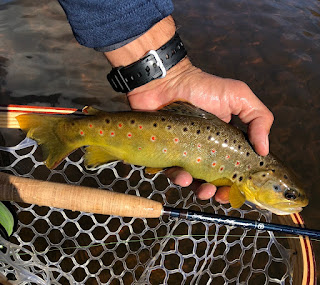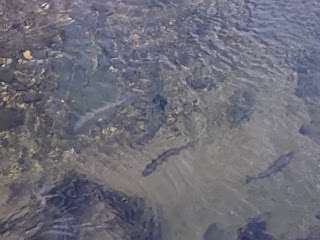Happy New Fishing Year! As we end ‘21 and enter ‘22, your best friends this week with be your weather app, local fly shops, and the online USGS stream gauges. Why?
Mother Nature will provide us with quite a variety. We’ll have a few remaining days of warmth, a couple of stormflow spikes mixed in, and then a big cool-down. Savvy anglers will be flexible.
Be ready to match your techniques and flies to the water flow, temperature, and turbidity (stain) conditions you face. Come up here armed with your 1) low&warm water, 2) high flow, and 3) winter water games and hit the flow curves with the right game. Our hitting tips, once again, are in the October 2020 edition of The Angler Magazine.
https://coastalanglermag.com/e-magazine/atlanta/
Check the long version of this report and Wes’ hot fly list on FB or by clicking on “fishing reports” at unicoioutfitters.com, which will take you to our blog. You’ll see how our angler gang adapted their techniques and patterns to the stream conditions they faced.
We’re open 8-1 tomorrow, closed on New Year’s Day, and finally back to regular business on the 2nd. May your new year start off great and stay that way. Send us your fish pics and stories! Good luck.
Wes’ Hot Fly List:
Dries: parachute Adams, stimulator, Griffith’s gnat.
Nymphs & wets: soft hackle partridge, red dart, tungsten pheasant tail, little black stone, simi seal leech, bead head hares ear, Pat rubberlegs and squirmy worms in high water.
Streamers & warmwater:
Kreelex, muddy buddy, clouser minnow, sweet baby cray.
GA public waters:
Bluelines:
Sautee and his photographer hit a high Hooch trib yesterday (29th) afternoon. The water was a balmy 55F at 2pm, slightly stained, and up just a bit from the very low fall base flow from the recent rain. Sautee had a big time on little wild bows to 7 inches. They preferred his #16 beaded hares ear nymph over the #14 Adams dry by a 3:1 margin. “Dries in December” was still a lot of fun during his brief local trip.
Smith DH:
It was running clear and 52F when I checked it at 10am today. Only two anglers were there. Shop and online fishing reports suggest it’s still fishing well for experienced anglers with a good drift. Since the stockers have now been in there a while and have seen a lot of flies, we suggest a “something different” strategy. Still toss a tiny egg or squirmy, but be ready to try some small (#16-20) nymphs and wets that have been forgotten in your box. If it’s new pattern or color, it might get more attention and takes.
Dukes:
We had two great reports from Smithgall vets taking advantage of yesterday’s storm surge.
Foothills TUer BobL:
“Only fished it for 2 hours yesterday, but did well. Micro squirrel leech, #14 BWO (2 on this and the big one) and the baby mop were my hot flies on 6x - 6.5x tippet.”
UO buddy Mo:
Rain in the forecast for Wednesday and we were up at Smithgall Woods before 7am, hoping to walk on. We pull up and there are 4 others before us looking to do the same. Not looking good. Luckily we all got to walk on, as many reservation holders didn’t show up for fishing on a rainy day.
Kurt and I started with a double nymph rig and we were into fish right away. The water was high and dirty, with a lot of debris and leaves, but that didn’t matter. We picked up fish in every likely hole. We both lost a huge fish each in that first stretch of creek. And I mean huge! Our 5x tippet just didn’t hold up.
By about 2pm the water cleared up and started dropping. A Peach egg worked all day, and an olive walt’s worm and Ron’s purple ronco were effective, too. It was another great day at Dukes.”
Chattooga DH:
Sautee’s duo gave it a shot on the 27th and said:
“Monday on The River found the water low, low, low and clear. We thought it was gonna be tough but we brought 15 to hand in the afternoon sun using a brown squirmy trailed by brown soft hackle. Stripped buggers only got a few follows. Our key to success was high-grading the honey holes (deeper water).
Hooch Tailwater:
UO buddy Mo:
Hey Jeff, I hope all is well. Here’s a little fodder from the hooch tailwater.
Kurt and I fished the lower pool below the dam today (26th). Ron was busy resting and digesting and couldn’t join us. It was a hot day for December and the river was still a little dingy from lake turnover, but the fishing was on fire.
Euronymphing with a two-fly rig produced over a dozen browns and just as many rainbows. They were eating small bugs today and a size 20 frenchie on a long (10ft) 7x tippet worked all day. We didn’t need to change flies at all.
Midges were hatching throughout the day but fish were not chasing them on the surface. You had to be on the bottom if you planned on catching any fish today. If you got it down to them, they ate!
The river is still clearing up and it will only get tougher to fool them when it’s gin-clear again at lake turnover. The little cloudiness in the water definitely helped today.
NC:
Dredger ran up to the national park on the 26th and had a decent day on small wild rainbows and one brown that might have hit 10 inches. The water was still low, but a bit higher after recent rains. A few midges and some tiny (#22) black stones buzzed around, but they only rose a few fish in a flat, glassy pool. He struck out on them.
After the slow start, things got better when he moved up to faster pools and changed his anchor fly from a silver sexy Walts to a black-beaded hares ear soft hackle, while keeping the hares ear nymph dropper. A roadside elk herd topped off his warm day in the Smokies. His pics and tips were posted on 12/27.
He went north again on the 28th and had good luck on a bunch of Nantahala DH bows and two stray browns. Water temp was 52 at noon and flows were a bit better after recent rains. The abundant stockers were partial to his sexy Walts anchor fly, while the four pretty wild bows preferred his peeking caddis dropper. Bugs were scarce (only a few tiny stones) and risers were nonexistent, so he stuck with Euro for the afternoon.
Here’s a pre-Xmas report from RonW that I forgot last week:
“Kurt, Moe and I hit Cherokee on 12/18 and 12/19. We arrived around 9:30am to a light but constant rain. We had a few hours of fishing before the rain really picked up. The water came up pretty fast and was stained to zero visibility. We still landed a fish a piece and each hooked into a goodun but couldn't seal the deal. The day seemed to fly by and was over before we knew it. We checked into the hotel and grabbed a quick bite to eat before hitting the rack.
We hit the water about the same time on Sunday and were pleasantly surprised to see the water came down a little and cleared up considerably. The bite was slow again to start but we all managed some fish. The guys caught some in the 14- 16" range and hooked into some giants as well but couldn't get them to the net. I only managed about a 12" rainbow but did have a nice brown smash my fly right at the end of my drift while I was lifting my rod to make another cast. He literally jumped right at me about 6' away and spat the hook back at me.
Around 3pm we ran into a Upstate NY transplant who was slinging streamers via a Trout Spey Rod. We talked with him and watched him work the 2-handed rod for a good 30 minutes. Pretty dang cool and I must say I need one ASAP. The ease in which he could toss a streamer across the whole River while hugging the bank was pretty impressive. While talking with him, we witnessed 3 very large trout come up and swipe at his streamer, one committed and commenced to breaking him off instantly. After seeing that, it was time to throw streamers. Kurt and Moe started wacking them instantly. Kurt was catching them on a game changer; Moe on the Kreelex. I had a couple really nice follows and one hookup who broke my whole rig off.
All in all, it was a fantastic weekend on the water with mah' brothers and I can't wait to do it again. Time to go watch some more spey videos! “
Private Waters:
UO Helen manager Wes:
I did a couple of trips on the Bend this week. With the warm water temps and the low flows, the key was to fish in fast water. Pheasant tails, soft hackles, and streamers produced well in the swift water where resident rainbows had to make quick decisions. In slower, deeper flows we were able to fool a few fish on small natural nymphs and eggs flies.
Hopefully we will see some increased flows with the rain throughout the rest of the week. That will only help the fishing!”
UO guide Palmer called in a report. He also had a good week guiding clients at Nacoochee Bend. His best bugs were egg flies, small dark nymphs, and even some small buggers in the faster water. His clients even scored a couple of doubleheaders!”
Flat Water:
HenryC says nothing is new on Lanier. He’s out there now, as I write this at 2pm Thursday. Some of the birds are heading father back in the coves, so that’s worth a look during your dawn recons. Just beware of muddy water way back in those coves as tributary streams dump their stormflows.
Henry did share a nice pic from his recent FL trip. An albie from the beach was a nice holiday gift!
www.henrycowenflyfishing
UO buddy Darren:
“We got out on Lanier for a few hours yesterday with my friend Michael. Unfortunately, fishing has been terrible for stripers as water temps are still too high. We did find some spots busting bait and fooled four. Cowen’s Somethin’ Else was the hot fly.”
Afar:
UO friend RonW:
“My wife and I made a day trip today (12-29) across the border into Tennessee to scout out the Tellico River.. After a quick stop at Tellico Outfitters to pick up some goods, a fishing license, and some local Intel, we were on our way.
We found the river up and stained upon arrival. I spent the day trying to find any soft water I could, looking behind large boulders and along the banks. I hooked into a nice 14" or so rainbow on the Ronco in the 2nd spot I tried, only to come unbuttoned shortly after. Not soon after that I got snagged and broke my whole rig off. I went to swinging streamers after that and that proved to be the ticket. I only managed two snits to hand all day, both on a streamer. I did however raise 3 larger fish, which were pretty cool to see. One was a brown pushing 20". He came up chasing a black Slumpbuster as I was stripping it back to me. I got a little too excited on the take and pulled it right out of his mouth. The 2nd one was a rainbow about the same size and about 10 yards downstream from the missed brown. He swiped at it a few times but couldn't get a hold of it. The 3rd chaser was about a 16" rainbow that came up out of nowhere right in front me. He went in for the kill, but it was almost as if he saw me at the last second and turned away.
All in all, it was a great day to spend in a new area with my wife and our dog Zoe. Considering the water conditions and the fact that I didn't expect to catch anything at all, I’ll take 2 fish and smile about it. I can't wait to get back there for a weekend trip and explore some more.”
We hope our intel helps y’all to ring in the new year in style. Call, stop in, or check us out online if we can help you further.
PS: go Dawgs!
Unicoi Outfitters: Friendly. Local. Experts.






































